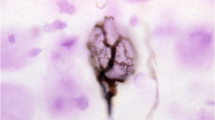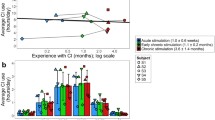Abstract
In the present paper, we review what is currently known about the effects of deafness on the developing human auditory system and ask: Without use, does the immature auditory system lose the ability to normally function and mature? Any change to the structure or function of the auditory pathways resulting from a lack of activity will have important implications for future use through an auditory prosthesis such as a cochlear implant. Data to date show that deafness in children arrests and disrupts normal auditory development. Multiple changes to the auditory pathways occur during the period of deafness with the extent and type of change being dependent upon the age and stage of auditory development at onset of deafness, the cause or type of deafness, and the length of time the immature auditory pathways are left without significant input. Structural changes to the auditory nerve, brainstem, and cortex have been described in animal models of deafness as well in humans who are deaf. Functional changes in deaf auditory pathways have been evaluated by using a cochlear implant to stimulate the auditory nerve with electrical pulses. Studies of electrically evoked activity in the immature deaf auditory system have demonstrated that auditory brainstem development is arrested and that thalamo-cortical areas are vulnerable to being taken over by other competitive inputs (cross-modal plasticity). Indeed, enhanced peripheral sight and detection of visual movement in congenitally deaf cats and adults have been linked to activity in specific areas of what would normally be auditory cortex. Cochlear implants can stimulate developmental plasticity in the auditory brainstem even after many years of deafness in childhood but changes in the auditory cortex are limited, at least in part, by the degree of reorganization which occurred during the period of deafness. Consequently, we must identify hearing loss rapidly (i.e., at birth for congenital deficits) and provide cochlear implants to appropriate candidates as soon as possible. Doing so has facilitated auditory development in the thalamo-cortex and allowed children who are deaf to perceive and use spoken language.








Similar content being viewed by others
References
Abbas PJ, Brown CJ, Shallop JK, Firszt JB, Hughes ML, Hong SH, Staller SJ (1999) Summary of results using the nucleus CI24M implant to record the electrically evoked compound action potential. Ear Hear 20(1):45–59
Baker CA, Montey KL, Pongstaporn T, Ryugo DK (2010) Postnatal development of the endbulb of held in congenitally deaf cats. Front Neuroanat 4:19
Bavelier D, Neville HJ (2002) Cross-modal plasticity: where and how? Nat Rev Neurosci 3(6):443–452
Bavelier D, Tomann A, Hutton C, Mitchell T, Corina D, Liu G, Neville H (2000) Visual attention to the periphery is enhanced in congenitally deaf individuals. J Neurosci 20(17):RC93
Bavelier D, Brozinsky C, Tomann A, Mitchell T, Neville H, Liu G (2001) Impact of early deafness and early exposure to sign language on the cerebral organization for motion processing. J Neurosci 21(22):8931–8942
Beiser M, Himelfarb MZ, Gold S, Shanon E (1985) Maturation of auditory brainstem potentials in neonates and infants. Int J Pediatr Otorhinolaryngol 9(1):69–76
Catalan-Ahumada M, Deggouj N, De Volder A, Melin J, Michel C, Veraart C (1993) High metabolic activity demonstrated by positron emission tomography in human auditory cortex in case of deafness of early onset. Brain Res 623(2):287–292
Dalal SS, Sekihara K, Nagarajan SS (2006) Modified beamformers for coherent source suppression. IEEE Trans Biomed Eng 53:1357–1363
Eggermont JJ (1988) On the rate of maturation of sensory evoked potentials. Electroencephalogr Clin Neurophysiol 70(4):293–305
Eggermont JJ, Salamy A (1988) Development of ABR parameters in a preterm and a term born population. Ear Hear 9(5):283–289
Fine I, Finney EM, Boynton GM, Dobkins KR (2005) Comparing the effects of auditory deprivation and sign language within the auditory and visual cortex. J Cogn Neurosci 17(10):1621–1637
Finney EM, Fine I, Dobkins KR (2001) Visual stimuli activate auditory cortex in the deaf. Nat Neurosci 4(12):1171–1173
Finney EM, Clementz BA, Hickok G, Dobkins KR (2003) Visual stimuli activate auditory cortex in deaf subjects: evidence from MEG. Neuroreport 14(11):1425–1427
Friesen LM, Picton TW (2010) A method for removing cochlear implant artifact. Hear Res 259(1–2):95–106
Gilley PM, Sharma A, Dorman M, Finley CC, Panch AS, Martin K (2006) Minimization of cochlear implant stimulus artifact in cortical auditory evoked potentials. Clin Neurophysiol 117(8):1772–1782
Glueckert R, Pfaller K, Kinnefors A, Rask-Andersen H, Schrott-Fischer A (2005) The human spiral ganglion: new insights into ultrastructure, survival rate and implications for cochlear implants. Audiol Neurootol 10(5):258–273
Gordon KA, Papsin BC, Harrison RV (2003) Activity-dependent developmental plasticity of the auditory brain stem in children who use cochlear implants. Ear Hear 24(6):485–500
Gordon KA, Papsin BC, Harrison RV (2005a) Effects of cochlear implant use on the electrically evoked middle latency response in children. Hear Res 204(1–2):78–89
Gordon KA, Tanaka S, Papsin BC (2005b) Atypical cortical responses underlie poor speech perception in children using cochlear implants. Neuroreport 16(18):2041–2045
Gordon KA, Papsin BC, Harrison RV (2006) An evoked potential study of the developmental time course of the auditory nerve and brainstem in children using cochlear implants. Audiol Neurootol 11(1):7–23
Gordon KA, Papsin BC, Harrison RV (2007) Auditory brainstem activity and development evoked by apical versus basal cochlear implant electrode stimulation in children. Clin Neurophysiol 118(8):1671–1684
Gordon KA, Tanaka S, Wong DD, Papsin BC (2008) Characterizing responses from auditory cortex in young people with several years of cochlear implant experience. Clin Neurophysiol 119(10):2347–2362
Gordon KA, Tanaka S, Wong DD, Stockley T, Ramsden JD, Brown T, Jewell S, Papsin BC (2010a) Multiple effects of childhood deafness on cortical activity in children receiving bilateral cochlear implants simultaneously. Clin Neurophysiol 122:823–833
Gordon KA, Valero J, Jewell SF, Ahn J, Papsin BC (2010b) Auditory development in the absence of hearing in infancy. Neuroreport 21(3):163–167
Harrison RV, Gordon KA, Mount RJ (2005) Is there a critical period for cochlear implantation in congenitally deaf children? Analyses of hearing and speech perception performance after implantation. Dev Psychobiol 46(3):252–261
Heid S, Jahn-Siebert TK, Klinke R, Hartmann R, Langner G (1997) Afferent projection patterns in the auditory brainstem in normal and congenitally deaf white cats. Hear Res 110(1–2):191–199
Jiang ZD, Zheng MS, Sun DK, Xiang LY (1991) Brainstem auditory evoked responses from birth to adulthood: normative data of latency and interval. Hear Res 54:73–88
Kral A (2007) Unimodal and cross-modal plasticity in the ‘deaf’ auditory cortex. Int J Audiol 46(9):479–493
Kral A, O’Donoghue GM (2010) Profound deafness in childhood. N Engl J Med 363(15):1438–1450
Kral A, Hartmann R, Tillein J, Heid S, Klinke R (2000) Congenital auditory deprivation reduces synaptic activity within the auditory cortex in a layer-specific manner. Cereb Cortex 10(7):714–726
Kral A, Tillein J, Heid S, Hartmann R, Klinke R (2005) Postnatal cortical development in congenital auditory deprivation. Cereb Cortex 15(5):552–562
Kral A, Tillein J, Heid S, Klinke R, Hartmann R (2006) Cochlear implants: cortical plasticity in congenital deprivation. Prog Brain Res 157:283–313
Leake PA, Hradek GT, Snyder RL (1999) Chronic electrical stimulation by a cochlear implant promotes survival of spiral ganglion neurons after neonatal deafness. J Comp Neurol 412(4):543–562
Lee DS, Lee JS, Oh SH, Kim S-K, Kim J-W, Chung J-K, Lee MC, Kim CS (2001) Deafness: cross-modal plasticity and cochlear implants. Nature 409(6817):149–150
Lee HJ, Giraud AL, Kang E, Oh SH, Kang H, Kim CS, Lee DS (2007) Cortical activity at rest predicts cochlear implantation outcome. Cereb Cortex 17(4):909–917
Lomber SG, Meredith MA, Kral A (2010) Cross-modal plasticity in specific auditory cortices underlies visual compensations in the deaf. Nat Neurosci 13:1421–1427
Mower GD (1991) The effect of dark rearing on the time course of the critical period in cat visual cortex. Brain Res Dev Brain Res 58(2):151–158
Nadol JB Jr (1997) Patterns of neural degeneration in the human cochlea and auditory nerve: implications for cochlear implantation. Otolaryngol Head Neck Surg 117(3 Pt 1):220–228
Nadol JB Jr, Young YS, Glynn RJ (1989) Survival of spiral ganglion cells in profound sensorineural hearing loss: implications for cochlear implantation. Ann Otol Rhinol Laryngol 98(6):411–416
Pantev C, Dinnesen A, Ross B, Wollbrink A, Knief A (2006) Dynamics of auditory plasticity after cochlear implantation: a longitudinal study. Cereb Cortex 16(1):31–36
Papsin BC, Gordon KA (2007) Cochlear implants for children with severe-to-profound hearing loss. N Engl J Med 357(23):2380–2387
Penhune VB, Cismaru R, Dorsaint-Pierre R, Petitto LA, Zatorre RJ (2003) The morphometry of auditory cortex in the congenitally deaf measured using MRI. Neuroimage 20(2):1215–1225
Ponton CW, Eggermont JJ (2001) Of kittens and kids: altered cortical maturation following profound deafness and cochlear implant use. Audiol Neurootol 6(6):363–380
Ponton CW, Moore JK, Eggermont JJ (1996) Auditory brain stem response generation by parallel pathways: differential maturation of axonal conduction time and synaptic transmission. Ear Hear 17(5):402–410
Propst EJ, Papsin BC, Stockley TL, Harrison RV, Gordon KA (2006a) Auditory responses in cochlear implant users with and without GJB2 deafness. Laryngoscope 116(2):317–327
Propst EJ, Stockley TL, Gordon KA, Harrison RV, Papsin BC (2006b) Ethnicity and mutations in GJB2 (connexin 26) and GJB6 (connexin 30) in a multi-cultural Canadian paediatric Cochlear Implant Program. Int J Pediatr Otorhinolaryngol 70(3):435–444
Ryugo DK, Pongstaporn T, Huchton DM, Niparko JK (1997) Ultrastructural analysis of primary endings in deaf white cats: morphologic alterations in endbulbs of Held. J Comp Neurol 385(2):230–244
Sharma A, Kraus N, McGee TJ, Nicol TG (1997) Developmental changes in P1 and N1 central auditory responses elicited by consonant-vowel syllables. Electroencephalogr Clin Neurophysiol 104(6):540–545
Sharma A, Dorman MF, Kral A (2005) The influence of a sensitive period on central auditory development in children with unilateral and bilateral cochlear implants. Hear Res 203(1–2):134–143
Shepherd RK, Hardie NA (2001) Deafness-induced changes in the auditory pathway: implications for cochlear implants. Audiol Neurootol 6(6):305–318
Smith KM, Mecoli MD, Altaye M, Komlos M, Maitra R, Eaton KP, Egelhoff JC, Holland SK (2010) Morphometric Differences in the Heschl’s Gyrus of Hearing Impaired and Normal Hearing Infants. Cereb Cortex [Epub ahead of print]
Stakhovskaya O, Hradek GT, Snyder RL, Leake PA (2008) Effects of age at onset of deafness and electrical stimulation on the developing cochlear nucleus in cats. Hear Res 243(1–2):69–77
Thai-Van H, Cozma S, Boutitie F, Disant F, Truy E, Collet L (2007) The pattern of auditory brainstem response wave V maturation in cochlear-implanted children. Clin Neurophysiol 118(3):676–689
Weitzman L, Graziani L, Duhamel L (1967) Maturation and topography of the auditory evoked response of the prematurely born infant. Electroencephalogr Clin Neurophysiol 23(1):82–83
Wong DD, Gordon KA (2009) Beamformer suppression of cochlear implant artifacts in an electroencephalography dataset. IEEE Trans Biomed Eng 56(12):2851–2857
Author information
Authors and Affiliations
Corresponding author
Additional information
This is one of several papers published together in Brain Topography on the ‘‘Special Issue: Brain Imaging across the Lifespan’’.
Rights and permissions
About this article
Cite this article
Gordon, K.A., Wong, D.D.E., Valero, J. et al. Use It or Lose It? Lessons Learned from the Developing Brains of Children Who are Deaf and Use Cochlear Implants to Hear. Brain Topogr 24, 204–219 (2011). https://doi.org/10.1007/s10548-011-0181-2
Received:
Accepted:
Published:
Issue Date:
DOI: https://doi.org/10.1007/s10548-011-0181-2




